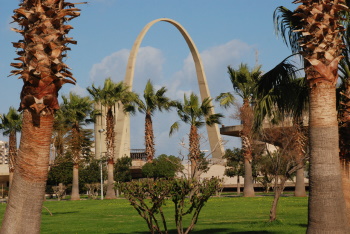Rachid Karami International Fair-Tripoli

The Rachid Karameh International Fair in Tripoli is a large-scale modernist exhibition complex.
It was designed by Brazilian architect Oscar Niemeyer and built between 1967 and 1975. It was a symbol of national pride and modernisation after independence. The fairground’s main structure, the curved Grand Canopy, is 70m wide and 620m long. The whole project wasn’t yet fully finished when the Lebanese Civil War broke out in 1975, and a new use hasn’t been found.
Community Perspective: all concrete structures are still there and appear to be undamaged. The entrance is free.

Map of Rachid Karami International Fair-Tripoli
Community Reviews
Triath

Visited in May 2023.
In this case, I was lucky, because the architectural project of Oskar Niemeyer received the status of world heritage in January 2023, at an extraordinary session, in a number of objects under threat, together with Odessa. The 1950s were a time of rapid development of Lebanon, which gained independence during WWII. One of the symbols of the country's economic success was planned to be a permanent International Fair Center in Tripoli, then a confident northern competitor of Beirut. The Brazilian Oscar Niemeyer, who was at the peak of fame after the creation of the new capital of his homeland, was invited for the design. The project of the fair complex was ready in 1962, but the implementation was delayed: it took a long time to buy the land, the objects were technically difficult for local engineers and contractors. Nevertheless, by 1975, 15 buildings and structures were erected in varying degrees of readiness: the entrance group, the main 750-meter boomerang-shaped pavilion, the Lebanon pavilion, a dome theater, an arch, an amphitheater, a helipad, a prototype of a collective residential unit, now quite unsuccessfully renovated into a hotel. All the buildings of the complex are made of concrete, Niemeyer's signature style.
But in 1975, a 15-year civil war began in Lebanon, then a Syrian military base was located on the territory of the exhibition center, and then Tripoli was gradually marginalized and fundamentalized, and the facilities fell into disrepair. Nevertheless, it is a typical, well-recognizable Niemeyer, with national motifs. This integration of Brazilian modernism of the 1960s in the Arab context can still be saved, thanks to UNESCO, it will now be much easier to do. It is not to say that the complex is currently under some obvious threat, rather it is about the need for conservation, which requires serious finances, which Lebanon is currently struggling with.
Bill Maurmann
The site is very rundown and dilapidated. Nevertheless Niemeyer's buildings are always imaginative and interesting. The site is reminiscent of the Sputnik era when we looked to what our space age future would be like. It reminded me of the 1962 Seattle Worlds Fair designed by his disciples that I visited when a child. Unfortunately his vision of wide open public spaces never seems to attract the masses as he intended. Even Brasillia felt empty and neglected. There were virtually no other visitors here, yet the grounds could have been a lovely park for families. The good news is that it has been identified as a future Arab convention center and Qatar and other Arab countries are planning to invest heavily into refurbishing it and bringing some prosperity into this rather depressed area of Lebanon
Christravelblog

Tripoli is Lebanon’s second largest city and a Tripoli day trip is worth it if you're in Lebanon. It’s a completely different world compared to Beirut. I left Beirut around 08:30 and was in Tripoli at 10:00. I visited both the International Fair and also Tripoli Old Town, both worth it!
Oscar Niemeyer designed the Rachid Karami International Fair in the late sixties for the World Fair in 1976. The fair ground was never finished as the civil war broke out in 1975. Today all the concrete structures are still there and not damaged by the war. The site is a 45-minute stroll as, honestly there isn't that much to see. I did climb, the tower, which was "partially locked". I think it wasn't allowed. Access is free to all the places. All buildings are empty but you can wander around freely.
When I visited, there was some youth event going on but a real new use for the place was never put in place.
I give it a 3.5 stars, as I like this architecture and this is certainly worth a place on the WHS list.
Read more from Christravelblog here.
Community Rating
Site Info
Site History
2023 In Danger
At inscription (Emergency Nomination), due to lack of financial resources of the State Party (in severe financial and economic crisis) and critical conservation conditions.
2023 Inscribed
2019 Revision
Successor to La foire Internationale Rachid Karameh de Tripoli-Liban (2018)
Site Links
Unesco Website
Connections
The site has 15 connections
Art and Architecture
Constructions
History
Timeline
Trivia
Visiting conditions
WHS Hotspots
WHS Names
WHS on Other Lists
World Heritage Process
Visitors
17 Community Members have visited.
The Plaque
No plaque has been identified yet for this site.